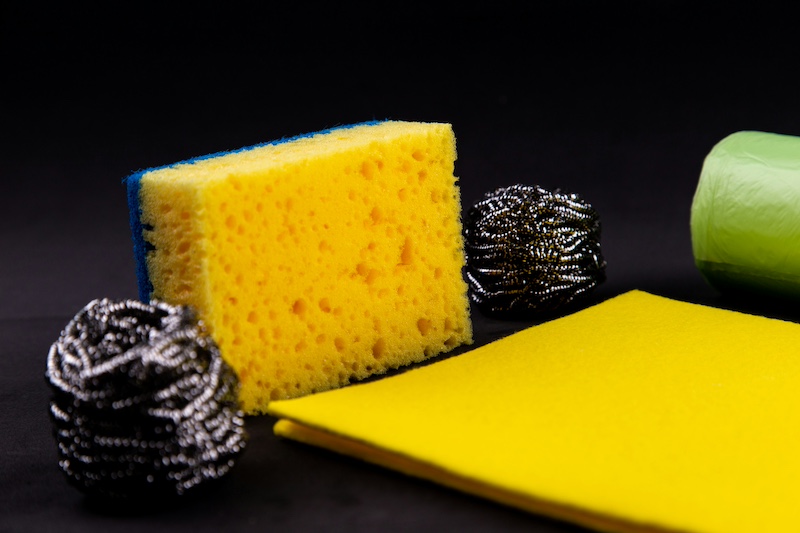Every basin needs to be cleaned regularly. Soap scum, residue toothpaste, and spit will stay and lie on the surface of the sink unless it is thoroughly swilled out and dried off after each use. Added to that are the natural minerals, including the dreaded limescale of hard water areas, which are in the water and will deposit on the basin surface and waste plug if left to dry naturally.
Furthermore, the waste plug, overflow channel, and bottle trap will all benefit from regular cleaning to reduce smells and blockages. Now, let’s dive deeper into how to care for and clean ceramic bathroom basins!
Table of contents:
- The effect of limescale in hard water areas on bathroom basins
- Cleaning limescale residue from bathroom basins
- Cleaning and caring for bathroom ceramic basins
- Cleaning the overflow
- Cleaning the waste, waste pipe and bottle trap
The effect of limescale in hard water areas on bathroom basins
Hard water staining in basins is very common. It is a build-up of the calcium in hard water which has dried (evaporated) off the basin surface, leaving this mineral behind. As this sits there and builds, it gets stained from the dirty water as the basin is used, giving it this yellowish-brown colour.
The harder the water, the quicker and heavier this will appear. You can check the hard water level of where you live here.

Cleaning limescale residue from bathroom basins
Here are a couple of tried and tested methods to remove limescale deposits from your bathroom basin:
- Agitate the buildup first by scrubbing the area with an old toothbrush or nail brush. Then use a vinegar mixture of equal parts white vinegar and water. Leave this sitting in the basin for up to an hour or so before giving the area another brush and then cleaning it with warm water to rinse away the deposits.
- For thicker, more stubborn areas of limescale, pour pure white vinegar over them rather than dilute and leave for 3-4 hours or overnight if needed. Again, rinse thoroughly afterwards to remove any residue.

Handy bathroom tip
When the vinegar and water solution is standing in the basin, in the final 15 minutes add any small items that need cleaning into the water, such as your soap tray or toothpaste cup.
Let everything sit for 15 minutes, then drain the sink, rinse and dry the items. This vinegar-water mixture is non-toxic, plus the acidity of the vinegar easily cuts through lime deposits and soap scum. It also evaporates quickly, leaving everything clean and shiny
Wipe over the sink and any remaining water with a dry cloth.
Cleaning and caring for bathroom ceramic basins
You can clean most bathroom sinks using a general bathroom cleaning spray and a soft cloth. These products are designed for ceramic basins and therefore are ideal. If you would prefer a more gentle option, use mild dish detergent or white vinegar mixed with water to cut through grime.
Keep an old toothbrush or another small, soft-bristled brush for scrubbing around the basin and waste drain.
Ideally, the basin should be cleaned every day and good practice is to spray, wipe out and dry the basin each night after your bedtime wash routine.

Cleaning the overflow
Some basins have an internal overflow, which prevents the basin from overflowing if the tap is accidentally turned on. This is an open hole to the drain and can get smelly if the drain blocks. It is also an area where bacteria can build. A spray of bleach or antibacterial will help to keep on top of this and keep the area clean.
If it does seem blocked or particularly smelly, then hot water and a sink cleaner or small bottle brush to clear the channel will do the trick.
An alternative method for dealing with stubborn smells or blockages:
- Funnel 1 cup of baking soda into the overflow
- Add 1 cup of white vinegar
- Let it fizz away for 15 or so minutes before funnelling very hot water into the overflow
- It goes without saying to take extra care not to scold yourself when doing the final flushing
Cleaning the waste, waste pipe and bottle trap
Hair, soap, toothpaste, foams, and shavings are just some of the things regularly washed down the waste plug. These can quickly build up, causing the basin to drain slowly and become very smelly.
To deal with this, open up the screw part at the bottom of the bottle trap to remove and clean it. This is the round part at the bottom—it will undo and make for easy cleaning.
Basin bottle traps can get bound very quickly with hair and soap scum. Also, heavier items such as jewellery or hair clips can be found and rescued.
Although I’ve not tried it, I have heard that a good trick to clean out any limescale buildup in the waste and bottle trap pipes is to empty a 2-litre bottle of coke (NOT DIET) into the basin and leave for at least four hours, although overnight is best if you can. The cola contains phosphoric acid, which is effective in breaking down limescale. Run the tap in the morning to flush out the debris, which has lifted and it should be left gleaming.

And there we have it! Hopefully, this guide is all you need to keep your ceramic bathroom basin clean. Why not check out our guide on everything you need to know about cleaning your bathroom?
















